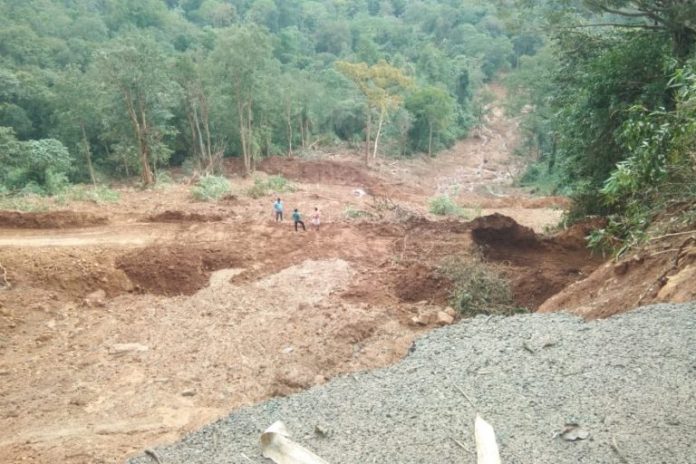
While Kerala’s contentious Athirapilly dam may be temporarily on hold due to peoples’ resistance, a smaller 7.5 megawatt hydropower project in the vicinity has got both environmentalists and indigenous communities worried. The Anakkayam Small Hydro Electric Project (SHEP), which will require the diversion of eight hectares of forests in Thrissur district and is just a stone’s throw from the proposed Athirapilly damsite, is all set to become a reality. An order from the Kerala State Electricity Board Limited (KSEB) dated September 3 has sanctioned the felling of hardwood trees in the forest land allocated to the Anakkayam SHEP. Operations are expected to commence soon; 1,897 trees will be axed. Indigenous communities living in the area and local activists are opposing the hydropower project, and their concerns are many.
“This hydropower project will involve the loss of rich forests,” said S.P. Ravi, secretary of the Chalakkudy River Protection Forum, a non-governmental organisation that has resisted the Athirapilly hydel project for more than a decade. “It violates not only the Forest [Conservation] Act but the Forest Rights Act and the State Disaster Management Act as well.”
A long history
The Anakkayam SHEP is a tailrace development project that aims to harness electricity from the water flowing out of the existing Sholayar hydro project. The project received environment clearance in 1990 itself, and the state government sanctioned eight hectares of forest land under the Vazhachal Forest Division for the project. However, the project was stalled for several reasons. The transfer of forest land was delayed by more than 20 years, causing its environmental clearance to stand cancelled. But in 2013-14, the project obtained both Stage-I and Stage-II environmental clearances.
Interestingly, as per the project details listed on the KSEB website, the project is being implemented as a Clean Development Mechanism (CDM) under the United Nations Framework Convention on Climate Change. A CDM, as per Article 12 of the Kyoto Protocol (which India is a signatory to), can earn a country certified emission reduction credits in recognition of the clean, green energy it produces or utilizes. But while the project may be clean (hydroelectric power is categorized as ‘clean’ because it is renewable and does not pollute unlike fossil fuels), the hydropower project may be anything but green.

Impact on local biodiversity
The forest land where the project is planned – which will involve razing down an unquantified number of small trees as well as 1,897 large trees including giants with a girth (or circumference) of more than 500 centimetres, according to Ravi – is home to tropical wet evergreen and semi-evergreen forests which support a diversity of wildlife. Fifteen acres of the eight hectares being diverted for the project under the Vazhachal forest division is part of the Parambikulam Tiger Reserve’s buffer zone, Ravi told Mongabay-India.
Surveys have recorded between 120 and 139 bird species in the Vazhachal Forest Division alone; these include species such as the uncommon Malabar pied hornbill Anthracoceros coronatus. A recent survey that assessed the impact of the 2018 floods recorded 196 bird species in the division; the area could be a “stronghold” of hornbills in the Western Ghats, the report found.
Birdwatcher and naturalist Susanth C., whose birdwatching group Warblers and Waders has been conducting surveys almost every year at Anakkayam and Vachumaram since 1995, has observed the state bird – the great hornbill – breeding in the area.
The Vazhachal Forest Division is also the only known home of the Athirapilly night frog, which was described in 2017. Frog biologist Sandeep Das (Kerala Forest Research Institute) has also encountered several individuals of the Cochin forest cane turtle (classified as “Endangered” as per the IUCN Red List) here. The region is home to 131 butterfly and 51 odonate (dragon and damselfly) species, including endangered species such as the Malabar tree nymph; as well as 1164 flowering plants, of which 103 are endemic to the Western Ghats. More than 60 species of mammals, including the Asian elephant, use the Division.
In fact, the area between Anakkayam and Vachumaram [which is part of the area where the SHEP will come up] is used by at least three herds of elephants, said biologist Sreedhar Vijayakrishnan who studied and followed elephants here for both his masters and doctoral studies.“A few solitary males too used that area,” he added. “There’s one herd, probably with an extremely small home range, in the Vachumaram range that uses the area round the year.”
Small hydropower projects in such areas are not devoid of impacts. A study in 2017 found that in Karnataka, there was a strong correlation between the construction of four SHEPs along the Netravati river and the onset of human-elephant conflict in the area.
Neglecting community forest rights and consent
Such forest loss can impact the indigenous Kadar community in other ways too. The location of the proposed Anakkayam SHEP – where the blasting for an approximately 5-kilometre-long tunnel will occur – is located within the 400 square kilometres of forest land that has been allocated in 2014 as community forest resources to the Kadar community here, under the Forest Rights Act (2006), say locals and activists. The Kadar rely on these forests for a range of non-timber forest produce, harvesting which is their only means of sustenance and livelihood. They also extract medicinal plants from the area, said Geetha V.K., chieftain of the Vazhachal settlement.
The excavation and construction for the project will occur very close to the Anakkayam settlement and the tunnel will go through the Sholayar settlement, she said. The proposed site of the SHEP is also close to a local sacred site that people in the Sholayar and Anakkayam settlements worship at and where they conduct annual festivals, she added. The stream in the vicinity is also used for fishing. Geetha and her community worry that their access to these natural and cultural resources will be affected by the implementation of the Anakayyam hydropower project.

And their fears are not without reason. A study in 2017 on the social and ecological impacts of small hydro projects found that the construction of four SHEPs in the Gundia river basin of the Netravati river in Karnataka severely restricted locals’ access to the river which they used to rely on for sustenance fishing because entry to the area from the reservoir to the tailrace canal was restricted. They also found that employment of locals in such projects – which is often listed among the benefits that such projects can accrue to local communities – was mostly temporary.
“Without the consent of the respective grama sabhas, this project [Anakkayam] cannot be taken up. And the KSEB never applied for their consent,” said Ravi.
High-cost project in an already sensitive area
Moreover, the Anakkayam settlement – near where the excavation for the Anakkayam project is proposed – is the same area that witnessed a fairly large landslide during the floods that the state saw in 2018. Any excavations here can enhance disaster risks, said Ravi. “And this is against the Disaster Management Act 2005.”
The costs that the project will incur is also far higher than the benefits it can accrue, he added. As of 2018, the Anakkayam project was budgeted at approximately INR 139 crore. Board orders uploaded on the KSEB website detail this, and that an amount of INR 61 lakh has been allocated as compensatory afforestation for the trees being logged. However, there can be no replacement for the loss of ecosystem services that these forests provide, said Ravi.
While he will have to refer to the specifics of the project to answer whether a site for compensatory afforestation has been identified, the KSEB has not done anything unlawful by initiating the Anakkayam project, said Chairman and Managing Director N.S. Pillai. “The project has obtained both Stage I and Stage II clearances from the Ministry,” he said.
Local resistance
In light of all these concerns, the Chalakkudy River Protection Forum will be launching a campaign against the project, clarified Ravi. Their demands are simple.
“We want the order to fell trees in the area to be withdrawn immediately, and the Anakkayam project cancelled,” he said.
Eight of the nine Kadar settlements in the vicinity have convened ooru sabhas or meetings and passed resolutions against the project, said Geetha.
“These have already been submitted to the Thrissur District Collector and officials in the Forest Department,” she said. “To us, every single tree is our god. We will resist the Anakkayam project just as we did the Athirapilly dam.”
Divisional Forest Officer Vinod S.V. confirmed that he had received the resolutions from the settlements and sent it to the Thrissur District Collector. Since the environmental clearance for the hydropower project was afforded before the community forest rights were granted, the legality of which order will hold will need to be ascertained, he added. Meanwhile, local activists are planning to voice their angst against the Anakkayam SHEP on November 18 by conducting protests across different locations in the state.
This article was originally published in The Mongabay.












